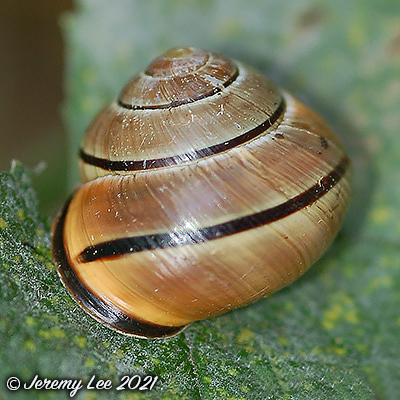
 |
|
Scientific Classifications explained » Amphibians » Ants » Aphids » Bees » Beetles » Birds » Bugs » Butterflies » Caterpillars » Damselflies » Dragonflies » Earwigs » Flies » Frog/Leafhoppers » Fungi » Galls » Grasshoppers » Harvestmen » Hoverflies » Lacewings » Ladybirds » Leaf Mines » Lichens » Mammals » Millipedes » Mosses » Moths » Sawflies » Slugs » Snails » Spiders » Trees & Shrubs » Wasps » Wild Flowers » Woodlice » Postboxes |
UK Nature > Snails > Cepaea nemoralis

Scientific Name: Cepaea nemoralis Common Name: Brown-Lipped Banded Snail Cepaea nemoralis, more commonly known as the Brown-Lipped Banded Snail, is a common terrestrial snail in the UK. Aside from the dark brown banding around the opening of its shell, the colour of the shell can vary greatly between snails, from very light to very dark. This polymorphism is thought to be help camouflage it. They like to live in a variety of habitats including grassland, hedgerows, woodland, sea cliffs and gardens. They prefer areas with plenty of moisture such as within thick undergrowth or in damp, dark soil, however in moist weather they will come out and climb up plants and trees, making them easier to spot. Brown-lipped snails are hermaphrodites, so have organs of both sexes. However, they need to mate in order for each snail to fertilise their own eggs. They then bury their eggs in soil. They are quite common throughout most of Britain, with the exception of the far north of Scotland. |
|

https://www.uknature.co.uk is a website dedicated to showing the immense diversity of UK nature and wildlife. Our vast range of habitats, from lowland arable to snow covered mountains, from storm-ravaged coastlines to peaceful inland freshwater lakes and rivers, from dry, sandy heaths to deciduous and coniferous forests, all these habitats contribute to the abundance of UK nature. We have wild birds in huge numbers either residing or visiting our shores (597 recorded species as at July 2013) and we must also not forget the humble back garden with its grass lawns, flower beds filled with nectar rich flowers, shrubs and trees, all designed to attract huge numbers of insects such as bees, moths, butterflies and hoverflies; and finally the small ponds which provide safe havens for frogs, toads, newts and even slow worms and grass snakes. www.uknature.co.uk is the showcase for my personal passion, photographing uknature in all its glory. I sincerely hope you all enjoy the fruits of my labours. This site and all images contained therein is © Jeremy Lee 2004 - 2025. All Rights Reserved. Site design by Jeremy Lee. Site development & IT Support by Stuart Lee. |